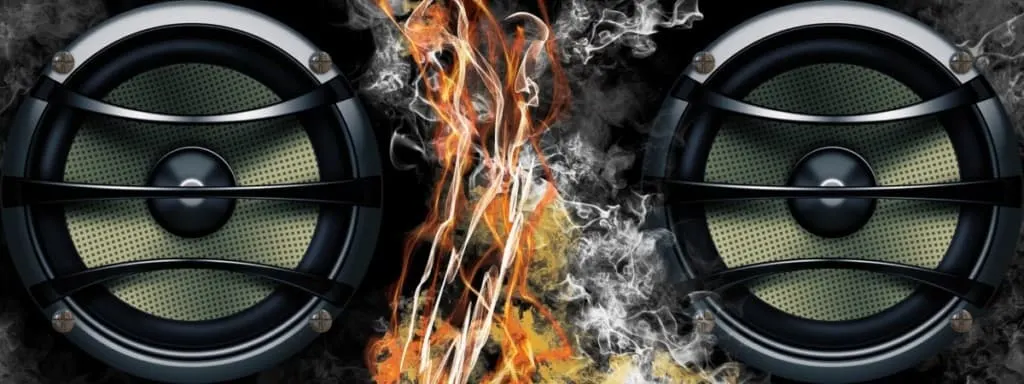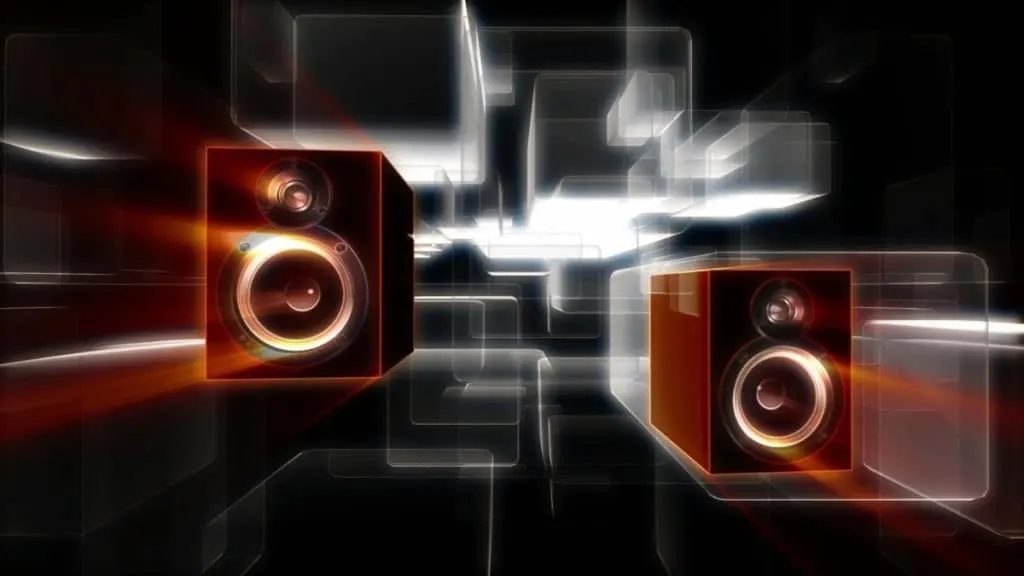Speaker monitors popping when turned on or off is potentially harmful to your speakers.
So, how do you stop speaker monitors from popping?
You can stop speaker monitors popping by following this easy rule: Powered speaker monitors should be powered off first and powered on last. Additionally, you should always first turn off the system before connecting, disconnecting, or powering the speakers.
There are different types of noises in speaker monitors (and audio equipment in general. Each noise has a separate cause and a different source.
Noise is simply an indication of some underlying problem, not the issue in and of itself. It is imperative to understand what kind of noise you are facing to rectify it and treat it correctly.
The following are some of the most common noises related to speakers and studio monitors:
- Digital Distortion or Buzzing Sounds
- Feedback
- White Noise aka Hissing sounds
- Popping or Crackling Sound
Of these, we will focus on the popping sound in speaker monitors that is mostly caused by the sound of the circuit capacitors discharging into the cone of the speaker. It is a common and innocuous problem. If it is not significantly loud, it will not be a major problem.
Yet, it is advised to learn the ideal order for shutting and starting things off to sidestep the chances of damaging your equipment. In this article, we’ll focus on the reasons why speakers and monitors tend to make popping sounds, especially when powered on and off.
Let’s look at the main highlights of this common noise-related issue with tips on how to get a risk-free and noise-free AV experience.

Solutions For Stopping Speakers From Popping:
At low volumes, most active speakers can handle an occasional spike caused by a sudden circuit change. It may not be dangerous per se, but will still be a nuisance to those who can hear it. It is strongly recommended to resolve the issue.
The culprit of this popping sound is hidden in the order in which we power down our audio equipment. The ideal order follows the mantra “monitors last on, first off”. If you are doing this and still hearing a pop then that could be for a variety of other reasons.
In the case of powered speakers, you can isolate the speaker monitors and connect them to their own source. This means you won’t use the same power supply for your computer and speaker. Sometimes, this simple trick will rectify several noise issues.
Speakers are susceptible to receiving ground when they are connected to the same power strip/supply as an audio interface and computer. This can result in various types of noise.
The Dangers Of Speakers Popping When Turned On Or Off
If you hearing a pop in active speakers (like computer speakers) or studio, then this is probably happening when you flip a switch to turn it on and off.
In fact, you’ll hear a similar “pop” when you abruptly disconnect the speakers while they are playing. This is bad for your speakers even though it is unlikely to wreck them at low volume.
So, the “pop” of a speaker or monitor is a transient spike.
What is a transient event? Commonly called a transient spike, it is an event where a quick and short burst of energy causes a spike in the wave. This is usually caused by a sudden change in the state of the speaker – like turning it on or off.
Although unlikely, a sufficiently large spike may loosen the speaker cone from its suspension mechanism. This depends on how much power (higher power = more chances of damage), and the type, quality, and strength of the speaker cone.
This problem is magnified with bigger speakers like high output PA speakers used in live events and concerts. The popping, in this context, can cause some serious issues as a spike may dislodge the speaker cone, which can stop it from working altogether.
You may have noticed that live venues often use a limiter at the output to prevent such incidents. The limiter will prevent the audio signal from surpassing a predefined limit. This limit is set to avoid any transient spikes from hitting the cone and causing damage.
This problem is a little less daunting if you are dealing with simpler and less powerful home audio equipment. Home speaker monitors operate at relatively lower levels, but that doesn’t make them impervious to damage. This is still a nuisance because of the strident and harsh sounds that they create. In the end, they severely diminish your AV experience.
It can be easily prevented with the recommendations we’ve made. It is advised to do so because, in the long run, it has the potential to damage smaller speakers of active monitors. And, it can reduce the life span of your equipment.
You may have to check the DC drift of your amp if the speakers are passive if this problem persists. It may not damage things at the output stage but anything over 50mV can harm both the speaker and the amplifier output stage.

Possible Design Flaws And Technical Issues:
If you are using studio monitors, popping can be caused by driver or software issues and your audio interface (sound card).
This can be either because you’ve set your buffer too low or software incompatibility. Check for the latest drivers online and also read the manual to ensure that your PC/system is compatible with the minimum requirements of the hardware/software.
Situations Where You Cannot Avoid Speaker Popping Sounds.
For instance, if your amp lacks an output relay (the thing that disconnects the speaker monitor when the power is switched off) then you will hear a pop. This happens because the speakers don’t get disconnected before the PSU capacitors lose charge. In this case, it is fine and you can’t do much about it anyway.
At times, it can be difficult to figure out where the problem lies in a large and convoluted setup.
If you can’t pinpoint why you are experiencing these sounds, you can try to isolate the speakers. To isolate them, check them with a different playback system or with headphones to see if the noise is consistent. You’ll eventually be able to identify the root of the problem.
If none of the above methods work, you should seek professional help. An electronics technician can check if your speakers need resoldering, new transistors, or something as simple as a bias adjustment. In any case, it will cost less to fix or replace a part than to ignore it and wear out your amplifier and speaker.
Choosing Gear Can Be Really Hard!
Home recording requires a whole series of equipment, and it can be difficult to do the research to figure out exactly what to buy depending upon your budget.
I have written a complete guide to exactly which equipment you should get depending on your budget.
Check Out this video on speaker popping!
Generic Tips For All Speaker Monitor Noise Issues:
You can follow these tips to get a clean and clear signal with minimal to no noise:
- Use high-quality cablhttps://www.amazon.com/s?k=Dynamode+6+Way+Horizontal+13a+Switched+Power+Distribution+Unit+%28PDU%29+Multi+Plug+Power+Strip+Electric+Charging+Station.+Made+Of+Aluminum+Alloy+With+Plug+Rackmount%2C+1.8M+Cable+for+Home%2C+Office+and+Industrrial+Use&crid=27N3BKN2GH2MV&sprefix=dynamode+6+way+horizontal+13a+switched+power+distribution+unit+pdu+multi+plug+power+strip+electric+charging+station.+made+of+aluminum+alloy+with+plug+rackmount%2C+1.8m+cable+for+home%2C+office+and+industrrial+use%2Caps%2C151&linkCode=ll2&tag=stampsoundusa-20&linkId=aa1f87bd5ab7d213e333105a8fd91ef5&language=en_US&ref_=as_li_ss_tles that are “balanced” whenever appropriate. Balanced cables are resistant to external interference as compared to other types of cables.
- Use a power strip with a noise reducer and surge protector like the Digital Energy EMI. These strips have built-in circuit breakers that protect against power spikes and overloads. Moreover, they have an attenuation filter to reduce/eliminate noise interference.
- You can also use a power conditioner (aka surge protector) like the PylePro PCO850 or the more advanced Pyle PCO875. This is ideal for home theaters, studio use, and compact audio equipment setups.
- Avoid over-amplification, as this will raise the noise floor. Additionally, don’t pump up the volume on your speakers or audio interface, as that will make the popping sounds more likely to cause damage.
Related Questions: Popping Speaker Monitors FAQ
Why do my speaker monitors sizzle, and/or crackle?
Crackling sounds from your speakers are usually caused by improper wire connections between the speaker and the amp. This could be because either the wire is faulty or it has come loose when you moved a speaker. You can simply replace and/or reconnect the wire to fix this problem.
Why do my speakers buzz, hiss, and/or hum?
These types of sound fall under the category of electrical noise. They are often caused by AC line noise or the ground loop. The cable wiring is creating a single-loop that attracts various types of noise. You can “break the loop” by using a single AC socket to power all equipment or you can invest in a hum eliminator like the Ebtech Hum X.
How to isolate the noise-related problem of speaker monitors?
When looking for the issue, try the elimination process to isolate the problem in your equipment. For example, if there is noise, you can start with cables and remove each cable one-at-a-time to eliminate each possibility.
One by one, you can isolate elements to see when the noise goes away. This will help you hone in on noise issues with certainty and ease.
I have written an article on using regular speakers as studio monitors. You can read it here.
Final Thoughts
I hope this post has simplified the basics of speaker popping and other generic noise-related issues.
Never attempt any complex repairs unless you truly understand the technicalities of your speakers. If the problem continues, ask an experienced professional to have a look at it. In most cases, popping noises at low volumes are okay, yet it is best to resolve the issues to avoid any long-term damage.
